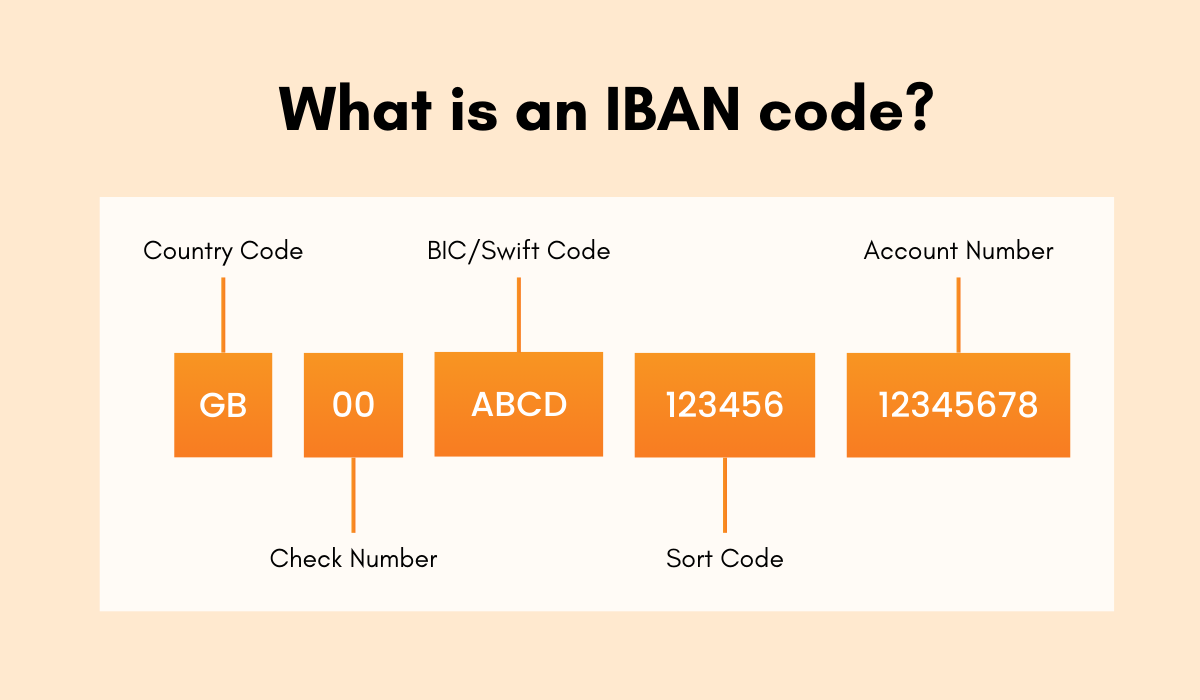Explained: What is a SWIFT Code?
An International Bank Account Number (IBAN) is a globally recognized code that facilitates secure and efficient international money transfers. Depending on the destination country, you may be required to provide an IBAN if you need to send or receive funds across borders. This raises the question: What exactly is an IBAN code?
Simply put, an IBAN is a unique alphanumeric identifier that helps accurately route payments to the correct bank account. It minimizes errors and speeds up transaction processing by verifying account details before completing a transfer. While IBANs are widely used in Europe and other regions, IBAN is not a standard practice in Canada, where banks rely on SWIFT codes and transit numbers instead. Understanding IBANs ensures smoother international transactions, reducing delays and preventing misdirected payments. Read our guide to learn how it works and its benefits for you.
How does an IBAN work?
An International Bank Account Number (IBAN) is a standardized international numbering system that simplifies bank account identification and minimizes errors in cross-border transactions. It ensures that money is transferred accurately by verifying the recipient's banking details before processing a payment. Research indicates that using IBANs reduces transaction errors to less than 0.1% of total payments, making it a globally trusted method for secure and efficient international transfers.
When sending money to a recipient's bank account, it’s not just important to understand the transfer process, but also to gather the recipient’s accurate information. If you’re transferring money to a country that uses IBANs, it’s crucial to have the beneficiary’s IBAN code. Additionally, you’ll need to provide the following details:
- Beneficiary Name
- Beneficiary Address
- Bank Name
- Bank SWIFT Code
- Bank Address
- Reason for Transfer
Your international money transfer provider will use the IBAN code to determine the country of origin and validate your recipient’s account number. This safeguards your funds and ensures that your IBAN transfer arrives quickly and securely.
While IBANs are widely used in Europe, the IBAN system does not exist in Canada, as Canadian banks rely on SWIFT codes and transit numbers for international transactions. However, if you are in Canada and sending money abroad to an IBAN-enabled country, you will still need to provide the recipient's IBAN to ensure your payment is processed smoothly. Without a valid IBAN, your transaction may be delayed or even rejected. To avoid errors, you can use an IBAN calculator to verify the correctness of an IBAN before initiating a transfer.
Understanding how IBANs work is crucial for Canadians making international payments. It helps prevent misdirected funds, reduce processing delays, and ensure seamless transactions worldwide.
What countries use an IBAN system?
The IBAN system is not used globally. According to the IBAN registry published by SWIFT, only 82 out of 195 countries have implemented it. Initially adopted by Eurozone banks, the IBAN became an international standard under ISO 13616:1997. Today, most European countries, including the United Kingdom, France, Italy, and Germany, rely on IBANs for secure, efficient cross-border payments.
Countries like Canada, the United States, and Australia do not use IBANs for domestic banking, instead relying on SWIFT codes and transit numbers. However, Canadians, Americans, and Australians can still send money through IBAN when making payments to regions that require it. To process an IBAN payment method, the recipient’s IBAN must be provided to ensure accurate and timely transactions.
Structure of an IBAN for Canadians
If you live in Canada and need to transfer money using an IBAN, it's important to understand how IBANs work. While IBAN Canada does not exist—meaning Canadian banks do not use IBANs for domestic transactions—you will still need to provide an IBAN when sending money to countries that require it.
Breakdown of IBAN Components:
- Country Code – The first two letters indicate the recipient’s country (e.g., "FR" for France, "DE" for Germany).
- Check Digits – Two control numbers that help detect errors in the IBAN.
- Bank Identifier – A unique set of characters that identifies the recipient’s bank.
- Account Number – The recipient’s specific bank account number.
For example, if you're sending money to a bank in France, the IBAN might look like this: FR76 30003 03620 00020216907 50
- FR (Country Code: France)
- 76 (Check Digits)
- 30003 03620 (Bank Identifier)
- 00020216907 50 (Account Number)
Before making an international payment, using an international bank account checker to verify the IBAN's validity is wise. This helps ensure your transaction is processed smoothly and reaches the intended recipient without errors or delays.
How IBAN differs from other banking codes?
When making international payments, you may encounter IBAN and SWIFT codes, both essential for cross-border transactions but serving different purposes. An IBAN (International Bank Account Number) identifies an individual bank account and its country. It can have up to 34 characters and ensures accuracy in international transfers.
A SWIFT/BIC code (Bank Identifier Code) is an 8 to 11-character code used to identify a specific bank or financial institution. Unlike an IBAN, which identifies a specific bank account, a BIC code helps locate the recipient's bank. SWIFT is a global payments network that standardizes both IBAN and SWIFT codes to facilitate secure transactions.
For Canadians, IBAN Canada does not exist- Canadian banks use SWIFT codes and transit numbers instead. However, when sending money to an IBAN-enabled country, providing the recipient’s IBAN is crucial. Using an international bank account checker before transferring funds helps prevent errors and delays.
How to find your IBAN?
If you’re planning to send money abroad, you may be learning about the best methods for international transfers and other key considerations. While exploring your options, make sure to check if you need the recipient’s IBAN to complete the transfer. If you do, here’s the correct way to go about it.
Bank statements and online banking portals
One of the easiest ways to find an IBAN is by checking bank statements or logging into an online banking portal. Many banks display the IBAN on monthly statements, particularly for accounts supporting international transfers. If you’re sending money through an online money transfer platform, ask your recipient to check their online banking dashboard, where the IBAN is often displayed alongside the account number and SWIFT code. Ensuring the correct IBAN is used helps prevent delays and failed transactions, providing a smooth international transfer experience.
Contact bank for IBAN details
If the recipient cannot find their IBAN through online banking or account statements, they should contact their bank directly. Banks can provide the correct IBAN based on the country's banking system. IBAN Canada does not exist for Canadians, as Canadian banks use SWIFT codes and transit numbers instead. However, when sending money from Canada abroad, you must request the recipient's IBAN to ensure a smooth transaction. Using the correct IBAN format in Canada for international transfers is crucial. It helps prevent errors and ensures funds securely reach the intended recipient without unnecessary delays.

Simplify your international transfers with MTFX
When sending money internationally, it's essential to prioritize accuracy, security, and cost-effectiveness. MTFX offers a reliable and efficient platform for Canadians transferring money overseas using IBANs and SWIFT codes, making international transfers seamless. Here are a few advantages of choosing MTFX:
- Competitive exchange rates – Get better rates than banks, saving you money on every transfer.
- Low transfer fees – Enjoy cost-effective international transactions with transparent pricing.
- Fast & secure transactions – Send money quickly and safely to IBAN-supported countries.
- Real-time exchange rate tracking – Lock in the best rates for your transfer.
- Personalized support – Get expert assistance for hassle-free transactions.
- Convenient online platform – Transfer funds anytime, anywhere, with ease.
With MTFX, you can confidently convert money from CAD to USD, JPY, or any other major currency and send money abroad while ensuring secure, accurate, and cost-effective transfers. Start your international payment today!
Got your IBAN? Send money abroad today
An IBAN ensures secure, accurate, and efficient international money transfers. Whether you're sending money from Canada to a country using the IBAN system or an online money transfer platform, ensuring the correct IBAN s iprovided can prevent errors, fraud, and unnecessary delays. Understanding how to find, use, and verify IBANs simplifies cross-border transactions, making global payments faster, safer, and more reliable. As a Canadian, always request the recipient's IBAN when sending funds abroad to ensure a smooth transfer process.
Create an account today and start your transaction through a reliable online money transfer platform.
FAQs
1. Does it cost money to use an IBAN?
Using an IBAN may not incur direct fees, but banks or transfer platforms may charge fees for international transactions. Check with your provider to understand costs related to IBAN payments.
2. Is it safe to give out an IBAN number?
Yes, it’s safe to share your IBAN for legitimate transactions. Like an account number, it’s only used to process payments to your account and doesn’t provide access to your funds.
3. How can I verify an IBAN?
Before sending money, use an international bank account checker or an IBAN calculator to verify the validity of an IBAN. These tools ensure that you have entered the correct details to avoid transaction errors.
4. How do I transfer money using an IBAN number?
To transfer money using an IBAN number, provide the recipient’s IBAN along with their name, bank’s SWIFT code, and other required details. Ensure the IBAN is accurate to prevent delays or errors in your IBAN payment method.
5. What is the purpose of an IBAN payment method?
By standardizing account identification, the IBAN payment method ensures secure, accurate, and efficient international transfers. It reduces errors, speeds up processing, and provides funds to reach the correct recipient.
6. Can I send money through IBAN without a SWIFT code?
No, for international transfers, you usually need both an IBAN and a SWIFT code. The SWIFT code identifies the recipient’s bank, while the IBAN specifies the account.
7. What are some benefits of using IBANs for international payments?
IBANs simplify cross-border transactions, reduce errors, enhance security, and ensure smooth payment processing. Using an IBAN calculator or similar tools ensures accuracy. Canadians sending money abroad should always request the recipient’s IBAN for a successful transfer.
8. What happens if I use an incorrect IBAN?
If you use an incorrect IBAN, the transaction may be delayed, rejected, or sent to the wrong account. Always verify the IBAN using an international bank account checker or contact your recipient for confirmation before sending money.
Copyright © 2025 MTFX Group



